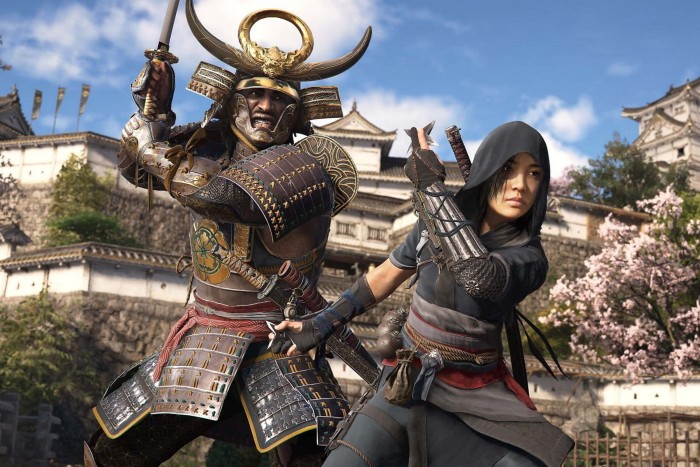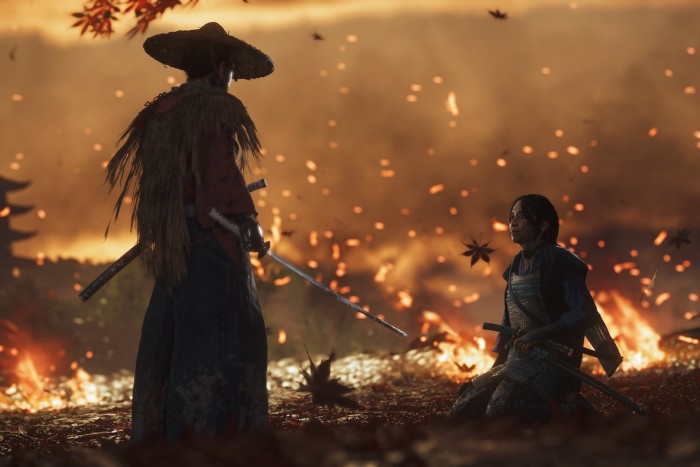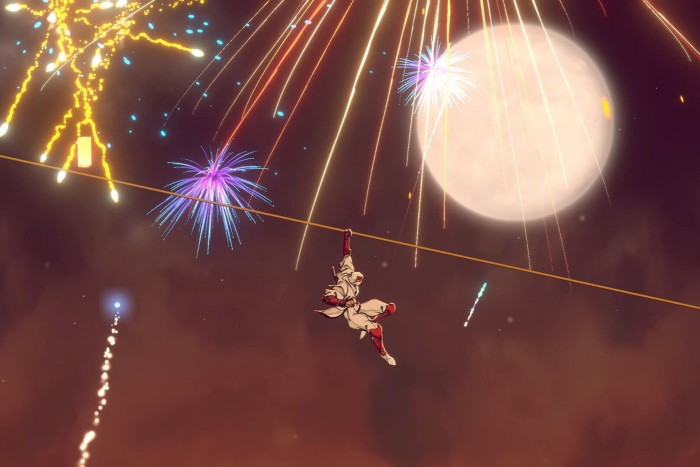The girl’s idyllic childhood in the Japanese countryside was cut short by a horrific act of violence. A group of masked men rode in, setting fire to her home and murdering her family. They left the girl for dead. She survived the attack but was now an orphan. Her hopes of a quiet life had been replaced by a single, burning desire: to exact revenge on the men who took away everything she knew and loved.
This dramatic scene is the introduction to Ghost of Yōtei, PlayStation’s new blockbuster open-world action-adventure game set in feudal Japan. If it sounds familiar, that might be because you’ve played Assassin’s Creed Shadows, another blockbuster open-world action-adventure game set in feudal Japan released earlier this year, which starts with an almost identical scene. The resemblance is eerie, down to the masks, the flames and the vows of vengeance.
Given how many years it takes to develop a game, this similarity is most likely a coincidence. They’re both tales of revenge, after all, and there’s an established formula for these things. However, the parallels point to something broader at play in 2025’s gaming landscape — we are deep into the year of the ninja.

The air is thick with drifting cherry blossom. The mountainsides are decorated with hot springs and wooden shrines. It’s all very pleasant, but why are so many games suddenly intent on teaching us the bushido code and immersing us in the politics of the shogunate? Do gamers have an urgent need for katana swords and tatami mats? Or is this merely a shallow fad, co-opting a foreign culture for its perceived mystique before moving on to the next trend?
When Ghost of Yōtei’s predecessor, Ghost of Tsushima, came out in 2020, it felt startlingly fresh. Set in the 13th century during the Mongol invasions, the story of samurai Jin Sakai was stylishly presented with strong visual nods to the films of Akira Kurosawa. There had never been an open-world game set in historical Japan with such lavish production values. Now, however, its sequel emerges into a crowded market. You can hardly move for throwing stars and haikus.
Yet Ghost of Yōtei sustains interest despite its familiar trappings. It’s an improvement on Ghost of Tsushima in every way, refining its combat systems and offering a far more compelling central narrative. We’re now in the 16th century, cast as revenging protagonist Atsu. After years working as a mercenary, she returns to her homeland, the northern wilds of Ezo, to exact revenge on the “Yōtei Six” who killed her parents. Voice actor Erika Ishii brings depth and heart to the steely protagonist.
Most of the game involves riding your horse through a vast, beautiful landscape, fighting off endless waves of enemies using a satisfying combat system, and performing standard-issue open-world side quests such as locating shrines, collecting bounties and finding maps. One innovation which will prove divisive is developer Sucker Punch’s idea to use the PS5 controller’s touchpad to get players to engage in activities such as playing the shamisen, frying fish and doing calligraphy. Some will find it immersive, others gimmicky.

At all times, Ghost of Yōtei wants you to be having a ravishing visual experience. It presents a semi-mythic Japan, whose landscapes overflow with flowers, drifting autumn leaves and flocks of cranes that always seem to be taking flight just as you pass by. Contravening the convention of stuffing the screen full of additional information — health bar, weapon types, button instructions — Yōtei keeps it minimal, allowing you to immerse yourself in its world without distractions.
One tiresome element of predecessor Ghost of Tsushima was how hero Jin would grumble that sneaking around like a ninja was dishonourable. One should fight fairly, which means approaching a foe and challenging them directly, rather than creeping around in the shadows. Samurais are about honour, justice and sacrifice, which is — of course — boring. Ninjas are where the fun is at. They use knowledge of their environment and an impressive arsenal of tools to sneak up on enemies unawares. Their role is strategic, silent, and just plain cool. Thankfully, Yōtei’s protagonist Atsu has fewer qualms about a stealthy approach.
Still, the game nudges you towards tackling combat encounters head-on. For a better approximation of the thrills of subterfuge, Assassin’s Creed Shadows is the place to go. This game is more conventional, overstuffed with map icons, complex levelling systems and mountains of busywork. But playing as its diminutive female protagonist, Naoe, is deeply satisfying as she races silently across tiled rooftops before leaping down to assassinate her targets, totally unseen.
Most of the year’s other ninja games lean into the thrills of acrobatic combat without fussing about stealth and patience. Ninja Gaiden 4, released later this month, is a flashy gauntlet of kinetic boss battles and spectacular action, challenging you to chain together elaborate combos and leave showers of gore in your wake. Meanwhile in the summer two old-school 2D ninja action games were released: Ninja Gaiden: Ragebound and Shinobi: Art of Vengeance, both offering satisfying retro combat with diverse art styles — the former a loving homage to classic pixel art, the latter adopting a gorgeous, hand-drawn aesthetic.

These action-oriented games are made by Japanese studios. It makes sense that, seeking source materials for their games, they would look to the action heroes of their own history. But Assassin’s Creed and Ghost of Yōtei are the products of western studios, and run the risk of continuing a long tradition of exoticising Japan, treating it as an aesthetic rather than a history. While both games present some hoary tropes, there has been an effort to engage with the culture more meaningfully — the protagonists of Shadows are a woman and a black man, whose narratives feel less familiar, while Yōtei includes a strand that delves into the history of the indigenous Ainu people, rarely presented in media.
Like any cultural medium, video games run in trend cycles. In the early 2010s, every game had to include archery. At the end of the decade, we were seeing Vikings everywhere. Now it’s the turn of the ninja. I must admit that, while none of these games are bad, I’m ready for something different. There are other periods of Japanese history to explore — the upcoming game Stranger Than Heaven is set across the 20th century, and it looks great. Meanwhile games that engage with other parts of the world, such as 15th-century Slovakia in Felvidek or the African Bantu mythologies in Tales of Kenzera: Zau, are refreshing. The year of the ninja has given us some great games, but at this point, I’d be happy for the ninjas to do what they do best, and vanish.
‘Ghost of Yōtei’ is out now on PS5


